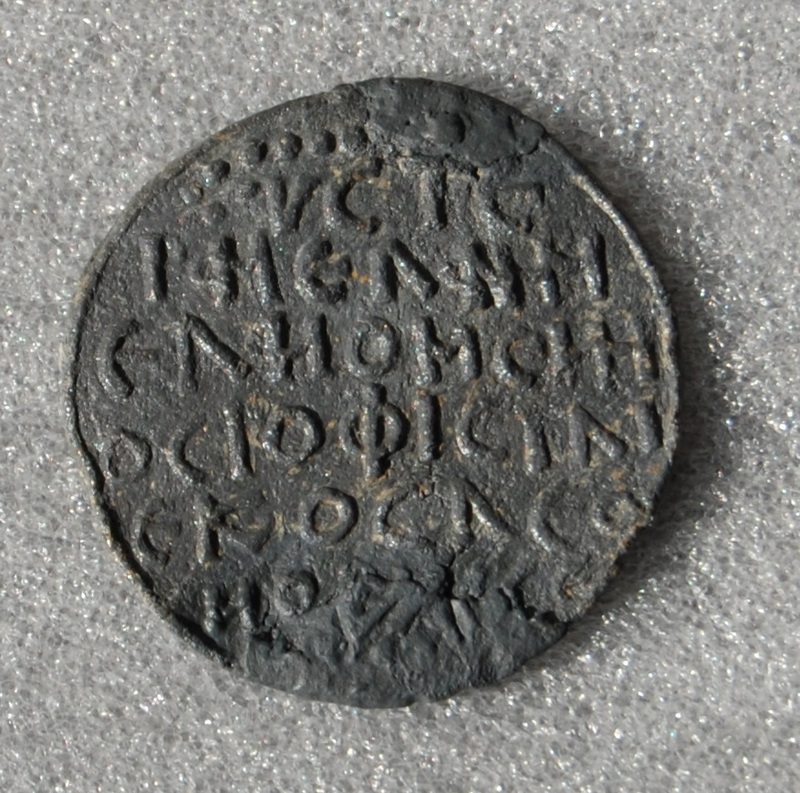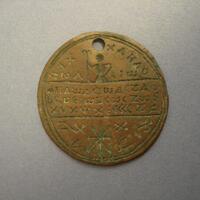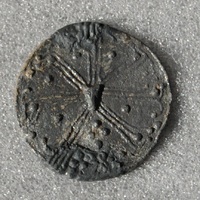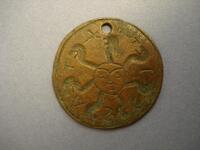Byzantine womb amulets
Type:
Amulets
Date:
Tenth century
Dimensions:
BM 1905,0531.1: 4.5 cm,
1995,0701.2: 4.7 cm
Description:
The womb (Greek hystera) was misunderstood in antiquity and the Middle Ages as a frightening independent creature that wandered around the body, causing ailments wherever it went. Written charms attempted to control the womb and the female hysteria it allegedly produced. Beginning in the tenth century, women wore or carried such charms in the form of amulets.
Byzantine womb amulets are dated between the tenth and twelfth centuries based on script style. They have a stylized uterus on one side and an inscription on the other. The uterus is depicted as a human face from which snakes or snaky creatures emerge; the image derives from Medusa, the female Gorgon of classical mythology. A tenth- or eleventh-century example in lead (BM 1995,0701.2) is inscribed on the reverse with the most common formula, addressed to the womb itself: "Womb black, blackening, you coil like a snake and you roar like a lion." Sometimes this formula continues with a request that the uterus calm down: "be gentle like a lamb and like a cat." Occasionally the formula is supplemented by the Trisagion or Psalm 90, which also appear on apotropaic jewelry.
A tenth-century womb amulet in copper was pierced to be worn as a pendant (BM 1905,0531.1). As on the lead example, this one has seven snaky heads, here unusually detailed. The Greek letters on both sides are legible but rarely compose recognizable words. Only the name of the archangel Michael can be read, flanking a small human figure above a series of magical letters.
Because of pregnancy and childbirth, women's health was always precarious and their life expectancy was short until modern times. The uterine amulets must have been considered potent by users across all social classes; examples survive in silver, gold, enamel, and precious stones, in addition to dozens in cheaper metals. Few Byzantine amulets have been found in situ, but they seem to have been produced in what is now Turkey and Greece.
Byzantine womb amulets are dated between the tenth and twelfth centuries based on script style. They have a stylized uterus on one side and an inscription on the other. The uterus is depicted as a human face from which snakes or snaky creatures emerge; the image derives from Medusa, the female Gorgon of classical mythology. A tenth- or eleventh-century example in lead (BM 1995,0701.2) is inscribed on the reverse with the most common formula, addressed to the womb itself: "Womb black, blackening, you coil like a snake and you roar like a lion." Sometimes this formula continues with a request that the uterus calm down: "be gentle like a lamb and like a cat." Occasionally the formula is supplemented by the Trisagion or Psalm 90, which also appear on apotropaic jewelry.
A tenth-century womb amulet in copper was pierced to be worn as a pendant (BM 1905,0531.1). As on the lead example, this one has seven snaky heads, here unusually detailed. The Greek letters on both sides are legible but rarely compose recognizable words. Only the name of the archangel Michael can be read, flanking a small human figure above a series of magical letters.
Because of pregnancy and childbirth, women's health was always precarious and their life expectancy was short until modern times. The uterine amulets must have been considered potent by users across all social classes; examples survive in silver, gold, enamel, and precious stones, in addition to dozens in cheaper metals. Few Byzantine amulets have been found in situ, but they seem to have been produced in what is now Turkey and Greece.
Relevant Textbook Chapter(s):
6
Repository and Online Resources:
• See the lead amulet on the British Museum website.
• See the copper amulet on the British Museum website.
Image Credits:
© The Trustees of the British Museum




